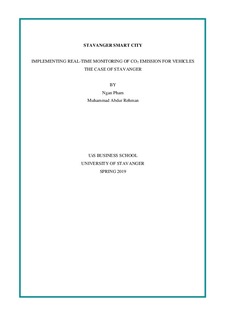| dc.contributor.advisor | Frick, Jan | |
| dc.contributor.advisor | Sandvold, Hilde | |
| dc.contributor.author | Abdur Rehman, Muhammad | |
| dc.contributor.author | Pham, Ngan | |
| dc.coverage.spatial | Stavanger, Norway. | nb_NO |
| dc.date.accessioned | 2019-09-11T12:49:43Z | |
| dc.date.available | 2019-09-11T12:49:43Z | |
| dc.date.issued | 2019-06-17 | |
| dc.identifier.uri | http://hdl.handle.net/11250/2616377 | |
| dc.description | Master's thesis in Strategy and Management | nb_NO |
| dc.description.abstract | The rapid urbanization has placed significant pressure on infrastructure and natural resources, leading to numerous consequences related to environmental, energy and climate issues. As such, the majority of countries have made effort to reduce greenhouse gas emissions and promote good urban environments. Norway has also placed high emphasis on maintaining environmental sustainability not only at the national but also at the local level. Joining this target, Stavanger Municipality is also working towards the fossil-free transport sector with the zero-growth target.
Over the last decade, the concept of “smart cities” has become more popular in terms of exploiting new technologies to help effectively address these challenges. However, there exists a situation that technological products and solutions are favored over end-users and their quality of life. Often citizens are only informed of what should be done without real engagement, resulting into cities less livable and far from their real needs.
Given the limited amount of literature on how smart city can help citizens achieve better living conditions in a sustainable environment, this thesis proposes an idea of implementing real-time monitoring of CO2 emissions for vehicles in Stavanger Municipality. In this research, both the municipality’s and the citizens’ point of view are taken into account, so the model can be considered to be applied in practice. On the one hand, the authorities can get more inhabitants involved in achieving both environmental gains and cost savings (sensors are installed at the existing facilities). On the other hand, citizens will get engaged in the national policy and feel contributing to it. In this way, the case study of Stavanger will outline the potential impacts of smart solutions on sustainability goals and citizen-centric approach. | nb_NO |
| dc.language.iso | eng | nb_NO |
| dc.publisher | University of Stavanger, Norway | nb_NO |
| dc.relation.ispartofseries | Masteroppgave/UIS-HH/2019; | |
| dc.rights | Navngivelse 4.0 Internasjonal | * |
| dc.rights.uri | http://creativecommons.org/licenses/by/4.0/deed.no | * |
| dc.subject | økonomi | nb_NO |
| dc.subject | administrasjon | nb_NO |
| dc.subject | strategi | nb_NO |
| dc.subject | ledelse | nb_NO |
| dc.subject | smart city | nb_NO |
| dc.subject | real time co2 | nb_NO |
| dc.subject | stavanger co2 emission | nb_NO |
| dc.subject | co2 emission Stavanger | nb_NO |
| dc.subject | Stavanger smart city | nb_NO |
| dc.subject | problem of CO2 in Stavanger | nb_NO |
| dc.title | Implementing real-time monitoring of CO2 emission for vehicles, the case of Stavanger | nb_NO |
| dc.type | Master thesis | nb_NO |
| dc.subject.nsi | VDP::Social science: 200::Economics: 210::Business: 213 | nb_NO |

